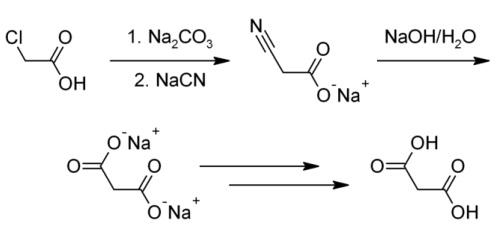-
外観
白色~ほとんど白色, 結晶~結晶性粉末
-
性質
マロン酸は白色もしくはほとんど白色の結晶あるいは結晶性粉末です。マロン酸の融点は135℃であり、常温常圧では固体です。
ただし、融点よりも少し高温まで熱すると、熱分解してとになります。また、マロン酸は、水、、などに溶けます。
-
定義
本品は、次の化学式で表される有機化合物である。
-
溶解性
水, エタノールに易溶。水、エタノール及びアセトンに溶ける。
-
解説
マロン酸,無色の針状結晶.分解点135 ℃.pK1 2.837,pK2 5.693.水,エタノールに易溶,エーテル,ピリジンに可溶,ベンゼンに難溶.140 ℃ で分解して二酸化炭素と酢酸になる.アミノ酸,そのほかの有機合成にしばしば用いられるほか,酸の一次標準物質としてアルカリ標準液の標定にも用いられる.強い刺激性がある.LD50 1.54 g/kg(ラット,腹腔).
森北出版「化学辞典(第2版)
-
用途
医薬?香料?合成樹脂?接着剤原料
-
用途
有機合成原料、酸の一次標準(アルカリ標準液の標定)、金属イオンのマスキング剤。
-
構造
マロン酸の化学式は、HOOCCH2COOH、分子量は104.06です。マロン酸は酢酸-マロン酸経路を構成するための物質の一つです。
マロン酸のジエステルは、活性メチレン化合物であり、塩基によりメチレンプロトンが引き抜かれて、容易にカルバニオンを生成します。そのため、炭素-炭素結合の形成に用いられています。
-
合成
マロン酸エステル合成 (英: malonic ester synthesis) とは、マロン酸のエステルから発生したカルバニオンを用いて、α-置換酢酸エステルを得る方法です。この反応でマロン酸エステルは、酢酸エステルのα-アニオン (ROC(=O)CH2−) の合成等価体として働いています。
もし、酢酸エステルやアセトンに強塩基を作用させて、安定したカルバニオンが生成できれば、ハロゲン化アルキルとのカップリングによって、同様の生成物を得ることが可能です。しかし、この手法ではアルドール縮合やクライゼン縮合といった副反応を併発する可能性があります。よってマロン酸エステル合成は、必ずしも強い酸や塩基が必要なく、C-C結合を作れるという点で、合成上の利点があります。
マロン酸エステル合成では、まずマロン酸エステルに塩基を加えて、カルバニオンを発生させます。生成したカルバニオンは、2個のカルボニル基と共鳴するため、大きな安定化効果を受けています。
このカルバニオンにハロゲン化アルキル (R-X) を作用させて、必要に応じて希酸で処理することで、加水分解と脱炭酸が容易に起こり、α-置換エステルを得ることが可能です。
マロン酸エステル合成によく似た手法として、アセト酢酸エステル合成もあります。
-
化粧品の成分用途
pH調整剤、香料
-
製法
クロロ酢酸にシアン化ナトリウムを反応させたのち加水分解するか,マロン酸ジエチルを加水分解すると得られるマロン酸.
-
説明
Malonic acid (MA), also known as propanedioic acid, is a dicarboxylic acid with structure CH2(COOH)2. It have three kinds of crystal forms, of which two are triclinic, and one is monoclinic. That crystallized from ethanol is white triclinic crystals.It decomposes to acetic acid and carbon dioxide at 140℃. It does not decompose at 1.067×103~1.333×103Pa vacuum, but directly sublimates. The ionised form of malonic acid, as well as its esters and salts, are known as malonates. For example, diethyl malonate is malonic acid's ethyl ester. The name originates from Latin malum, meaning apple.
-
化学的特性
Malonic acid is a white crystalline solid that decomposes at approximately 135°C. It has high solubility in water and oxygenated solvents and exhibits greater acidity than acetic acid, which has a pK value of 4.75. The pKa values for the loss of its first and second protons are 2.83 and 5.69, respectively. It is slightly soluble in pyridine. It can decompose to formic acid and carbon dioxide in case of potassium permanganate. Since that malonic acid generates carbon dioxide and water after heated without pollution problems, it can be directly used as aluminum surface treatment agent.
-
使用
Malonic acid is used as an intermediate in the manufacture of barbiturates and other pharmaceuticals. It is a component used as a stabilizer in many high-end cosmetic and pharmaceutical products. Malonic acid is also used as building block in chemical synthesis, specifically to introduce the molecular group -CH2-COOH. It is used for the introduction of an acetic acid moiety under mild conditions by Knoevenagel condensation and subsequent decarboxylation.
-
主な応用
Malonic acid is acts as a building block in organic synthesis. It is also useful as a precursor for polyesters and alkyd resins, which is used in coating applications, thereby protecting against UV light, corrosion and oxidation. It acts as a cross linker in the coating industry and surgical adhesive. It finds application in the production of specialty chemicals, flavors and fragrances, polymer cross linkers and pharmaceuticals.
-
定義
ChEBI: Malonic acid is an alpha,omega-dicarboxylic acid in which the two carboxy groups are separated by a single methylene group. It has a role as a human metabolite. It is a conjugate acid of a malonate(1-).
-
製造方法
Malonic acid is usually produced from chloroacetic acid.
Reaction: The chloroacetic acid is added to the reaction kettle by adding sodium carbonate aqueous solution to generate sodium chloroacetate aqueous solution, and then 30% sodium cyanide solution is slowly added dropwise, and the reaction is carried out at a predetermined temperature to generate sodium cyanoacetate. After the cyanation reaction is completed, add sodium hydroxide for heating and hydrolysis to generate sodium malonate solution, concentrate, then dropwise add sulfuric acid for acidification to generate malonic acid, filter and dry to obtain the product.

This method often does not produce a pure enough product or the pure product has an extremely low yield. Industrially, malonic acid is also produced by hydrolyzing dimethyl malonate or diethyl malonate. This manufacturing method is able to bring about a higher yield and purity, but the organic synthesis of malonic acid through these processes is extremely costly and environmentally hazardous.
-
反応性
In a well - known reaction, malonic acid condenses with urea to form barbituric acid. Malonic acid is also frequently used as an enolate in Knoevenagel condensations or condensed with acetone to form Meldrum's acid. The esters of malonic acid are also used as a - CH2COOH synthon in the malonic ester synthesis.
-
生物学の機能
Malonic acid is the classic example of a competitive inhibitor of the enzyme succinate dehydrogenase (complex II), in the respiratory electron transport chain.It binds to the active site of the enzyme without reacting, competing with the usual substrate succinate but lacking the ?CH2CH2? group required for dehydrogenation. This observation was used to deduce the structure of the active site in succinate dehydrogenase.
-
一般的な説明
White crystals or crystalline powder. Sublimes in vacuum.
-
空気と水の反応
Water soluble.
-
危険性
Strong irritant.
-
火災危険
Flash point data for Malonic acid are not available; however, Malonic acid is probably combustible.
-
病理学
マロン酸値の上昇に、メチルマロン酸値の上昇が伴う場合には、複合マロン酸およびメチルマロン酸尿合併症 (英: Combined malonic and methylmalonic aciduria) という代謝性疾患の可能性があります。血漿中に存在するマロン酸とメチルマロン酸の比率を計算して、古典的なメチルマロン酸尿症と区別することが可能です。
-
使用用途
マロン酸はリンゴに含まれていたことから、医療分野などで香料として使用されています。その他、カルボキシ基という官能基を持っていることから、合成樹脂やのような分野で、原料としても使われています。
-
生物学的応用
The calcium salt of malonic acid occurs in high concentrations in beetroot. It exists in its normal state as white crystals. Malonic acid is the classic example of a competitive inhibitor: It acts against succinate dehydrogenase (complex II) in the respiratory electron transport chain.
-
概要
マロン酸とは、カルボキシ基 (-COOH) を2つ持ったジカルボン酸の一種です。
塩の場合には、マロナートもしくはマロネート (英: malonates) と呼びます。マロンの名称は、ギリシア語のリンゴに由来します。マロン酸のCAS登録番号は141-82-2です。
安全に保管するため直射日光を避け、換気のよいなるべく涼しい場所に密閉して保管する必要があります。また、安全な容器包装材料としてが指定されています。
-
純化方法
Crystallise malonic acid from *benzene/diethyl ether (1:1) containing 5% of pet ether (b 60-80o), wash with diethyl ether, then recrystallise it from H2O or acetone. Dry it under vacuum over conc H2SO4. [Beilstein 2 IV 1874.]


